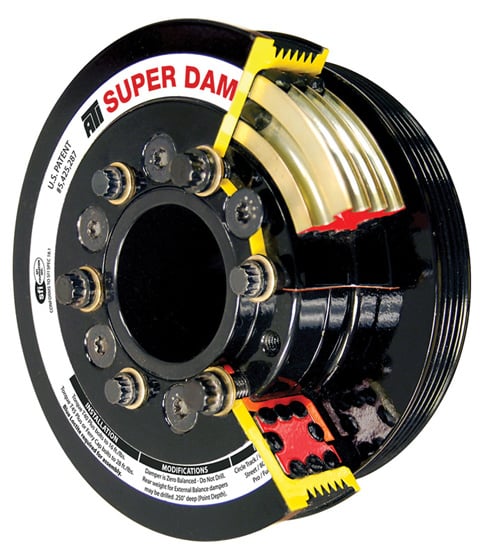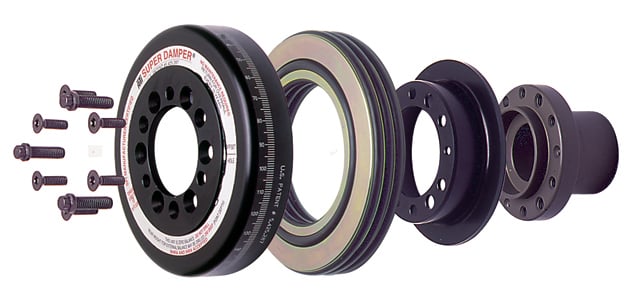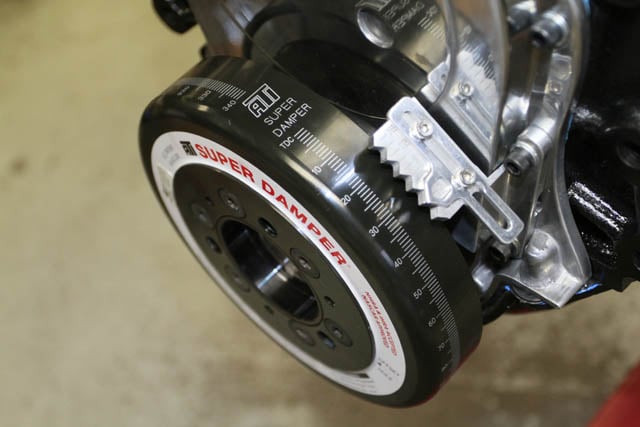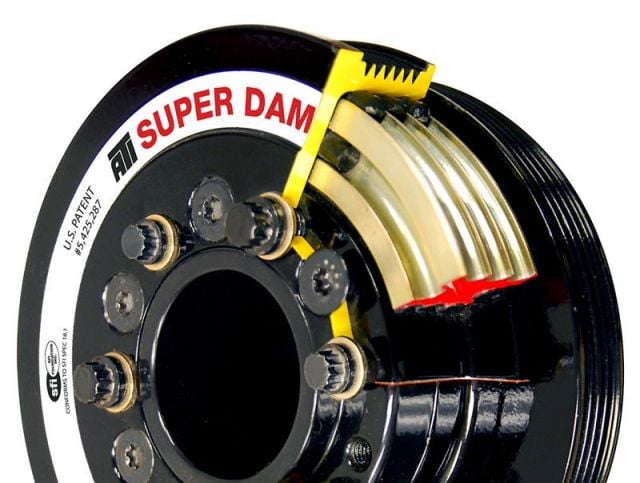918436
ATI Performance® (05-08) Mopar V8 (7.48" OD) Super Damper™ Serpentine Damper
- In stock, ready to ship

Compatible: (5.7L/6.1L)
2005 - 2008 Chrysler 300
2006 - 2008 Dodge Charger
2008 Dodge Challenger
2005 - 2008 Dodge Magnum


The patented ATI Super Damper is the only crankshaft damper designed exclusively for high performance Chevy engines.
Inner and outer shells are available in aluminum or steel, and contain a steel inertia weight. This inertia weight has six (2-ring design) or eight (3-ring design) computer machined grooves to retain the proper durometer O-rings (dyno tested for each application).
Outside Diameter: 7.500"
Finish: Black Zinc Chromate
EngineLabs: What are the strongest contributing factors to crankshaft vibration, and which ones are hardest to measure and accurately predict?
Beattie, Jr: Crankshaft harmonics, vibrations or torsionals can all be used interchangeably for the casual talking points. Remember that torsional twist, is a twist without a bend. When you get a twist with a bend, nothing good comes of it. Crankshaft twist is inherent to the rotating assembly in any engine. You will always have pistons on a compression stroke, a power stroke or going up and coming down. This causes the crankshaft to twist. Too much of this twist leads to bearing failure, and eventual crankshaft failure. Many other things are a byproduct of this twist as well. Unchecked crankshaft twist when it does not fail the crankshaft or bearings, will show up in other ways and is often overlooked as being the culprit. A poor performing, or undersized damper that does not properly counteract this twist will allow oil pump failures, timing drive system failures, flexplate or flywheel bolts that come loose, distributor gear failures, and other various gremlins.
 EngineLabs: How has the elastomer damper design changed over the past 20 years and what’s the future for this technology?
EngineLabs: How has the elastomer damper design changed over the past 20 years and what’s the future for this technology?
Beattie, Jr: The biggest change in elastomer dampers has been the type of materials that can go in them. As rubber develops and companies can use new types of vulcanized rubber to join steel pieces of the damper together, the longer those dampers will last. However the ATI Super Damper became the first damper to utilize two separate sized O-rings on a single inertia mass, and be fully captured inside the shells. An OEM-style damper with two pieces can easily separate, rotate and lose timing marks, or totally fail and come apart. The Super Damper took care of those issues and gave engine builders a package that allowed them to build with lighter engine parts, and turn more rpm, and still keep the torsionals in check.
EngineLabs: In terms of controlling crank vibrations, how much more effective is an internally balanced rotating assembly than an externally balanced assembly?
Beattie, Jr: A well done externally balanced engine will perform just as well as a copy that is internally balanced. However, for higher rpm and fast-revving race engines, internally balanced engines are inherently easier on components and have a better overall life. The reason being is that the mass to counteract the rotating assembly is right where it needs to be. When torsional twist travels on a crankshaft, it runs from the front to the back of the engine, always passing through the middle, mind you. If the mass for the proper balance is there, the better off you are. We have done torsional testing of an internally balanced engine on a circle-track motor that was zero balanced, then 2 percent over and 4 percent over to be sure the torsionals did not change greatly, and the effect was minimal.
EngineLabs: What criteria should engine builders consider when choosing a damper size? What are the pros and cons of larger/smaller dampers?
Beattie, Jr: Size matters. The smaller and lighter the damper, doesn’t make it better. The damper needs to be properly sized for the engines displacement, horsepower, max rpm and the application of the engine. An 864ci motor with a small 5-pound damper might as well not run one at all. And a 305ci motor with a 15-
pound damper is not helping itself either. When we spec a Super Damper for a boat, off-road truck or road-race car, we like to use a steel hub on the crank with an aluminum shelled damper assembly. In general, the larger the cubic inch, horsepower and rpm, the larger the damper needs to be to do its job. The correct sized damper will allow the engine to make more horsepower and live longer. Dampers don’t make horsepower, they allow the motor to run how it was designed to run, for the camshaft timing to stay stable, and the engine to live longer. A couple extra pounds on the front of an engine can save a lot of headaches from ever occurring in the first place.
EngineLabs: Engine harmonics is a complicated issue, but what are the talking points that engine builders should know about when selecting parts and setting up the specs to minimize the effects of harmful vibrations and harmonics?

Beattie, Jr: What applications are you building for? Drag racing, road racing, off road, etc. Crankshaft material; cast usually absorbs more low-range torsionals on a torquey low-rpm motor, while a billet crank can live longer and take more sheer horsepower and rpm. Crank weight is important as well. Too light and you will have bearing failures and broken cranks, no matter what damper you run. However, when the crank is heavy for the horsepower and rpm, the damper generally needs to be heavier too with a softer rubber compound to do the job. Some sanctioning bodies like NASCAR do not allow ATI to supply aluminum dampers or parts for safety reasons. Steel dampers are our only choice for the Cup, Nationwide and Truck engines, and other organizations have similar rules. So you better find out before spec’ing a damper. Good main caps are important for torsionals as are the fasteners. If you are constantly getting a burnt bearing, or set of bearings, take a close look. If they are worn from the middle out, and used up almost all the way to the edges, you are doing good. If only the middle, or only the edges are worn, and the other contributing factors are not showing issues, then you have torsional twist going on that a properly sized damper will help.
There’s no denying the fact that piston engines shake, some more than others. The vibration that is created by an engine has to be controlled somehow, and this is the reason why torsional dampers exist. We all understand that fact, but what are
dampers? Is their power to be found by having the correct one for your application?
These are the questions that we wanted to get answered also. So we went to the torsional damper experts to find the answers to our questions. Our friends at Fluidampr, TCI Auto, and ATI Performance Products fielded all of our questions and you might be quite surprised to find out how this often ignored piece of equipment is vital to the health of your engine.
How Shake Happens
Consider that a piston stops traveling altogether twice per revolution (at the top and bottom of the cylinder) and you can imagine how much energy that represents. Then the shock from the connecting rod, and transfer those forces to the crankshaft. Finally, add the difference in torque that is applied to the crank, and all of this is working to twist that crankshaft, loading and unloading it like a spring.
On your gramma’s grocery-getter, the damper’s weight doesn’t matter; but on high-performance engines, every bit of weight counts.
While we recognize the damage such vibrations do directly to crankshafts, these vibes can also degrade components like distributors or accessories like your alternator, oil pump, etc. Not to mention if the crankshaft flexes too much, it can throw off your cam timing and rob you of power.
Crankshaft vibration is inherent in any internal combustion engine because of the powerful yet uneven forces that act directly on the crankshaft. Understand, a damper will not add horsepower, but crankshaft vibration will handicap the engine’s horsepower potential.
“Design engineering can calculate the harmonics; but testing also shows where the frequencies are,” said Brian LeBarron at Fluidampr. “When you make performance upgrades, you can change where the critical harmonics occur.” The ‘bad’ harmonics build up in a complicated but predictable way, that’s why dampers are tuned for specific uses, as well as for specific engines.
“While your motor is running, you have some pistons that are being pushed downward on a power stroke, some that are being pulled down by the crankshaft, and then there are some that are being pushed upward by the crankshaft,” explained ATI’s J.C. Beattie Jr. “Now think about this entire system happening 8,000+ times per minute!”
The vibration damper reduces these harmonics (particularly the larger, more-destructive “lower order” vibrations) and keeps them from building on each other. Engineers figure out where the harmonics come into play.
On your gramma’s grocery-getter, the damper’s weight doesn’t matter; but on high-performance engines, every bit of weight counts, and rotating weight particularly, since it accelerates with engine speed, and also because it produces a gyroscopic effect. Engine modifications can move the harmonics outside the tuned range of the OEM damper, making it useless.
How Do They Work?
Several approaches to damper design are popular, some are complicated and some are simple. Three popular designs dominate:
Elastomeric dampers work well against the predetermined, big, crank-destroyer first-order harmonics. The pendulum type’s manufacturer says it can confuse nearly all the harmonics, small to large. Viscous dampers are effective across a broad frequency range to protect against the crank-destroying and secondary harmonic effect.

The ATI Super Damper uses two concentric rings – an inner one to connect to the crankshaft directly, and an outer one, with weight and diameter designed to counteract the torsional vibrations of the crank.
Elastomeric dampers typically use two rings of metal, separated by an engineered polymer. One ring attaches to the crankshaft, the other ring is heavy and is matched to a particular engine’s known vibration frequency at a specific rpm, where that inherent harmonic can do the most damage. The two rings are separated from each other by elastomers, typically scientifically-designed polymeric “O” rings.
OEM dampers are usually of the simplest and cheapest elastomeric type. Rubber is poured or forced between concentric steel two rings in a liquid state; then it dries in place. There are usually serrations on the OD of the inner ring and the ID of the outer to help hold this rubber strip in place.
For example an ATI Super Damper uses two concentric rings – an inner one to connect to the crankshaft directly, and an outer one, with weight and diameter designed to counteract the torsional vibrations of the crank. Between these are two O-rings of such size, shape and material to allow the optimum tuning for your particular application.
Over time in your street car, that rubber can deteriorate through exposure to oil, temperature, and mechanical fatigue. Performance elastomeric dampers on the other hand, are much more robust, not to mention rebuildable like ATI’s Sumper Damper. ATI’s J.C. Beattie Jr. notes, “You say OEM dampers are ‘cheap!’ I have been told an OEM damper for a very popular V8 has a cost to them of under $10… And guys will put that on their $30,000 engine!”
“Your stock damper, or stock style damper, is simply a piece of soft steel that has a rubber ring that has been melted in between another steel ring,” Beattie explained. “The inherent problem with that design is that there is no way to maintain concentricity of the inertia ring during manufacturing.” Beattie went on to claim, “Through many years of testing and tuning, the O-ring style Elastomer damper has proven to be the best choice for performance applications, especially when high RPM is being applied.”
Viscous Dampers
The viscous damper was invented in 1946 by Vibratech TVD (formally Houdaille and parent to Fluidampr). Vibration resonates an internal inertia ring causing it to shear back and forth through a thin layer of highly viscous silicone fluid. The shearing action transforms the energy into heat, which safely radiates through the outer housing. Specialized silicone fluid (on average 45,000x more viscous than 30w oil) is used, as it has proven to have good thermal stability, plus it has high tensile strength and heat dissipation properties. The fluid style is considered by its maker as effective on a wider range of rpm.
Because the fluid is not significantly degraded if used within its operating ranges for temperature, vibration, and rpm, maintenance is ordinarily required only if the unit is physically damaged. These are also popular in long-life, high-shock applications, like diesel trucks, and off-highway equipment.
Fluidampr’s LeBarron notes, “Each of our damper applications are engineered and tested to the actual vehicle, rpm range and conditions it’s expected to encounter. Well, for example, our new CT Gold series dampers have been developed for today’s higher rpm circle track cars. The centering technology feature allows a CT Gold series damper to be balanced with the rotating assembly, plus provide enhanced torsional vibration control for sustained RPMs above 6000.”
Fluidampr claims their silicone fluid will not freeze or thin out with ambient or engine temperature changes, or go bad with age or from sitting idle. Unless physically damaged (or if the press fit has been lost from repeated removal), Fluidampr says their damper will last the life of the engine in performance applications.
The “pendulum” damper like the TCI’s Rattler’s design evolved from oil-filled aviation designs, and consists of tuned weights whose masses, indirectly connected to the crankshaft, take up the “snap” produced by the torsional vibrations. Being tuned to frequencies outside the engine’s own, they work on multiple frequencies, and may continue to work well, even after, say, a piston-style change.
Scott Miller at TCI says, “The weights inside the Rattler are different diameters, and they are balanced, depending on the engine type and firing order. These pucks actually roll [in a dry environment] within their cylinders, and are ready at the crank’s end just when the vibration is trying to ‘exit’ the crankshaft. This action effectively absorbs the action of the crank.” The Rattler is inaudible except at shutdown, as the engine drops below about 500 rpm, when the pucks can get free from the normal centrifugal force.
“The damper in a stock application – the OEM setup – is ideal for that engine,” said Miller. “But any time you make changes in the engine – and not just the crank and rods and pistons, but even a carburetor – these changes can make your OEM damper ineffective. Do other dampers work? Yes; but wouldn’t you rather eliminate the vibrations, rather than dampen them? The Rattler extends the frequency range and eliminates the vibrations, rather than just toning them down.”
The Rattler lives with a reputation as a noisy thing. The noise is evident at shutdown, but only as the engine drops below about 500RPM and centripetal force no longer keeps the internal pucks plastered to the outsides of their bores. “The myth of ‘greater maintenance’ is something I’d like to see go away. Plus, your whole engine will last longer – less engine maintenance on those expensive parts is where you save money,” said Miller.
What Do They Do?
When your crankshaft’s twisting moments build up, the crank fights back, and when the loads are high enough, the crank’s return to “normal” is a violent reaction, sometimes nasty enough to break that big expensive piece of metal. A torsional vibration damper can lessen the sharpness of the buildup, and also relieve the tension a bit slower; these two actions greatly lower the loads on the crank itself. The extra energy is then transmitted through the damper, resulting in a measurable buildup of heat. The materials of the damper (either elastomer or fluid) are designed to be effective through the predicted range. (The TCI Rattler has no rubber and contains no liquids, and so doesn’t generate heat.)
One advantage of all high-performance dampers is that timing marks are prominent on their circumference, giving you a built-in degree wheel for setup and tuning. Although not as precise as a large-diameter degree wheel that would never fit under the hood, they provide a reliable, available reference for all sorts of field work and routine tuning.
Popular Myths:
Dampers don’t add horsepower, like Miller explains, “We don’t push the Rattler as a horsepower enhancer, what it does is extend the life of the engine.” Dampers allow the engine to live longer, of course, that means that you can now do other things that would shorten its life (like adding horsepower).
One manufacturer claims a “45 hp increase” on one race engine that switched to its damper, and cites a well-documented example. They explained to us, “Basically going from the wrong damper, to the best one, you can get huge amounts of power.” True – just as you can gain power by going from the wrong camshaft to the best one. The right damper is always better than a mismatched one.
Tips:
Keep in mind the tradeoffs between damping ability and weight: more weight (other things equal) means better damping. But other things aren’t equal – larger diameters can sometimes increase the damping effect without adding weight, because the weight is working on a longer lever arm.
| Type | Main Advantages | Main Disadvantages | Examples |
| Viscous Fluid | works across slightly broader range of frequencies than elastomeric; works in particularly tough (e.g., diesel) applications | relatively expensive; reduces vibrations in tuned frequency band only | Fluidampr, Fluidampr CT Gold |
| Elastomeric: | cheap (OEM) to expensive; effective within its predetermined limits; good in high-rpm applications; often rebuildable | reduces vibrations in specific, tuned frequency only; could be damaged | ATI Super Damper |
| Pendulum | effective over full range of rpm; does not generate heat | relatively expensive; noisy in low RPMs, less common in race applications | TCI Rattler |
| no damper | free; weightless; takes no space | permits all torsional vibrations |
Your original engine probably incorporated a damper, typically integrated with the pulley on the end of the crankshaft. (The flywheel and clutch or torque converter typically deal with harmonics at the other end.) Replacing that damper pulley with a “power pulley” (generally promising to lower overall weight and the rpm of accessories and water pump, reducing “power drain” from accessories and eliminating the possibility of the water pump’s cavitation at high rpm) will do nothing to attenuate torsional vibration, and may reduce your crankshaft’s life by a factor of [some literature claims] ten.
Installing Fluidampr’s CT-Gold Damper on a Chevy Performance CT-350
It’s good to plan ahead, but order your damper only after your engine’s design and makeup are pretty well set. Know what the clearance around your damper mount will be; then determine which model of your favorite torsional vibration damper will work best. For all applications that are outside “essentially stock,” you’ll need to know more than your engine size and model: your working rpm range, compression, aspiration (turbo, supercharged?); did you change internal components (pistons, rods, crankshaft, camshaft or cam drive, lifter type, flywheel, clutch or torque converter) or major drivetrain components (driveshaft / length, transmission or differential )?
To Spend, Or Not To Spend?
Fluidampr’s LeBarron explained to us, “When you talk about a $20,000 engine, is the extra $400 for a good damper to protect it really expensive? You’ll also free up lost hp and torque (a very small amount, but measurable).”
We all hate to add weight, and a torsional damper looks like another chunk of stuff we’d be better off without. That depends, of course, on how long you want your engine to last. For most folks, longer life is worth it.
One of the manufacturers explained to us, “As you know, there’s plenty of unsupported claims, mis-information, skewed testing, mudslinging rivalries and those sorts amongst the aftermarket and racing worlds.” The fact is, the good dampers will protect your engine, if properly matched. Choosing one should be based on your mission, your plans for the engine, and the research you do.
Install Guide:

Warranty: